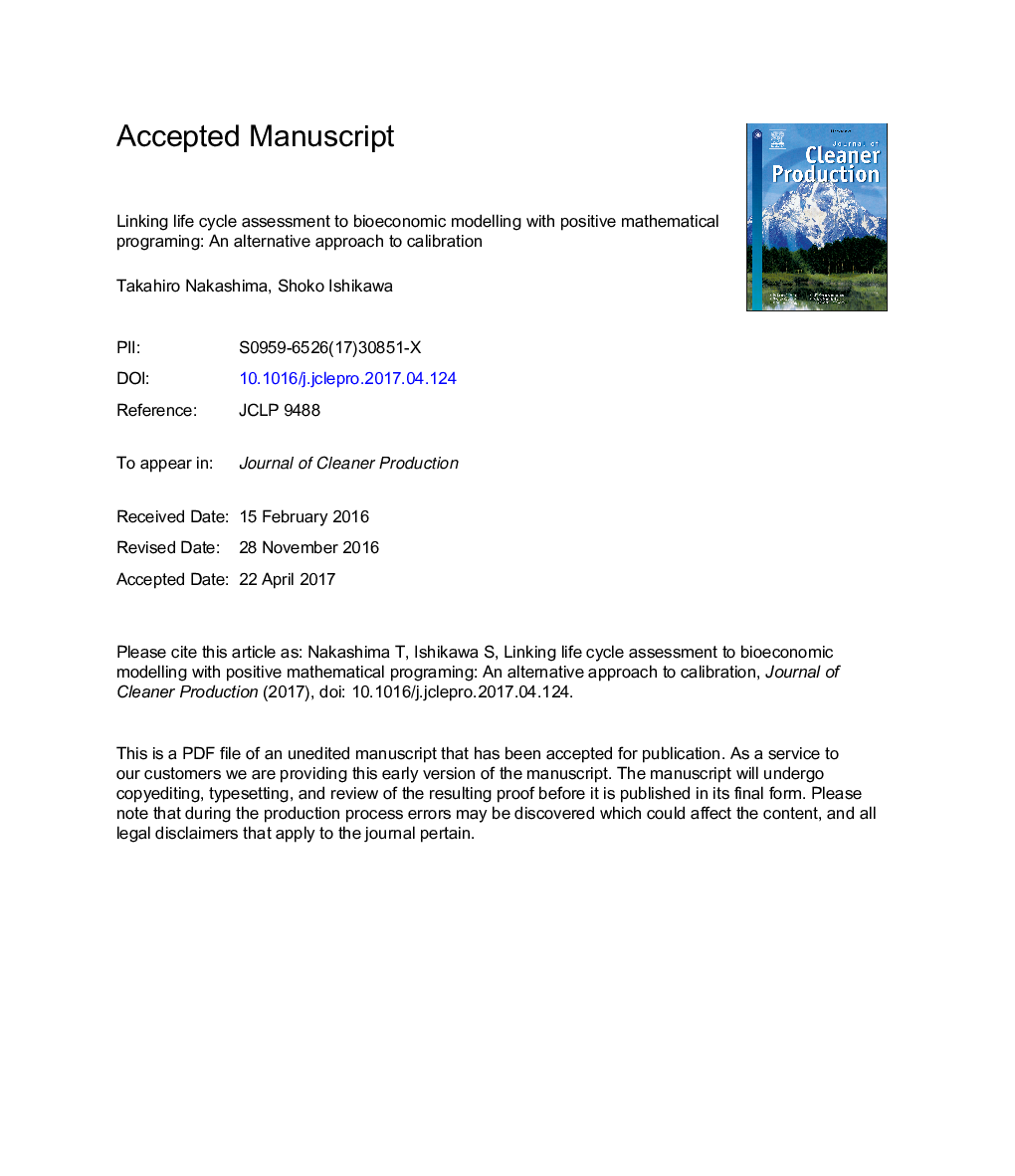| کد مقاله | کد نشریه | سال انتشار | مقاله انگلیسی | نسخه تمام متن |
|---|---|---|---|---|
| 5479498 | 1522087 | 2017 | 38 صفحه PDF | دانلود رایگان |
عنوان انگلیسی مقاله ISI
Linking life cycle assessment to bioeconomic modelling with positive mathematical programming: An alternative approach to calibration
ترجمه فارسی عنوان
پیوند دادن ارزیابی چرخه زندگی با مدل سازی بیولوژیکی با برنامه ریزی مثبت ریاضی: رویکرد جایگزین برای کالیبراسیون
دانلود مقاله + سفارش ترجمه
دانلود مقاله ISI انگلیسی
رایگان برای ایرانیان
کلمات کلیدی
ارزیابی چرخه حیات، استفاده از زمین، انگیزه های اقتصادی، برنامه ریزی مثبت ریاضی، انتخاب کالیبراسیون،
ترجمه چکیده
افزایش توجه به گسترش استفاده از ارزیابی چرخه حیات کشاورزی با پیوند دادن آن با مدل های بیولوژیکی با برنامه ریزی مثبت ریاضی. مطالعات پیشرفته قبلی ممکن است از کاربران بالقوه (مثلا سیاستگذاران) پشتیبانی ناکافی در یافتن ابزار موثر برای مدیریت یک صنعت کشاورزی را به شیوه ای پایدار ارائه دهد. این بخشی ناشی از این واقعیت است که برنامه ریزی ریاضی مثبت ارتدوکس شامل روش های کالیبراسی متعدد است که تولید تخصیص اصلی زمین را در نقطه مرجع تکرار می کنند، بدین معنا که آنها به عنوان تعداد روش های کالیبراسیون به عنوان بسیاری از نتایج شبیه سازی تولید می کنند. برای بررسی بیشتر، مطالعه حاضر، یک روش برای استفاده از نتایج شبیه سازی برای تعیین یک روش کالیبراسیون پیشنهاد کرد. به عنوان یک تصویر، روش پیشنهاد شده به یک سیستم برداشت بلند در هوکایدو ژاپن اعمال شد. مشاهده شد که روش کالیبراسیون انتخابی از روش میانگین هزینه، روش که اغلب در عمل استفاده می شود، برای مجموعه داده های مشخص شده بیشتر شده است. روش پیشنهاد شده در مطالعه حاضر انعطاف پذیری نسبت به روش های قبلی با توجه به فرایند انتخاب روش های کالیبراسیون بود و می توان آن را یک گام در جهت هماهنگ سازی استفاده گسترده از ارزیابی چرخه زندگی با مدل سازی زیست محیطی دانست. سپس نتایج به دست آمده برای مدل های بیولوژیکی و ارزیابی چرخه حیات کشاورزی مورد بحث قرار می گیرد. در این مطالعه، یک روش تحلیلی جدید برای دانش موجود در مورد استفاده گسترده از ارزیابی چرخه زندگی با مدل های اقتصادی بیولوژیکی اضافه شده است.
موضوعات مرتبط
مهندسی و علوم پایه
مهندسی انرژی
انرژی های تجدید پذیر، توسعه پایدار و محیط زیست
چکیده انگلیسی
Increased attention has been paid to extending the use of agricultural life cycle assessment by linking it to bioeconomic models with positive mathematical programming. Previous extension studies might have provided insufficient support to potential users (e.g. policymakers) in finding effective means of operating an agriculture industry in a sustainable manner. This is partly a result of the fact that orthodox positive mathematical programming involves numerous calibration methods that reproduce the original land-area allocation at the reference point, implying that they generate as many simulation results as the number of calibration methods themselves. To have more of an impact, the present study proposed a procedure for using simulation results to determine a calibration method. As an illustration, the proposed procedure was applied to an upland cropping system in Hokkaido, Japan. It was observed that the selected calibration method outperformed the average cost method, the method used most frequently in practice, for the specified dataset. The procedure suggested in the present study proved to be more flexible than previous approaches with respect to the selection process of calibration methods, and it could be regarded as a step toward harmonizing the extended use of life cycle assessment with bioeconomic modelling. Implications for bioeconomic models and agricultural life cycle assessments are then discussed. The present study adds a new analytical method to the existing knowledge on the extended use of life cycle assessment with bioeconomic models.
ناشر
Database: Elsevier - ScienceDirect (ساینس دایرکت)
Journal: Journal of Cleaner Production - Volume 167, 20 November 2017, Pages 875-884
Journal: Journal of Cleaner Production - Volume 167, 20 November 2017, Pages 875-884
نویسندگان
Takahiro Nakashima, Shoko Ishikawa,
